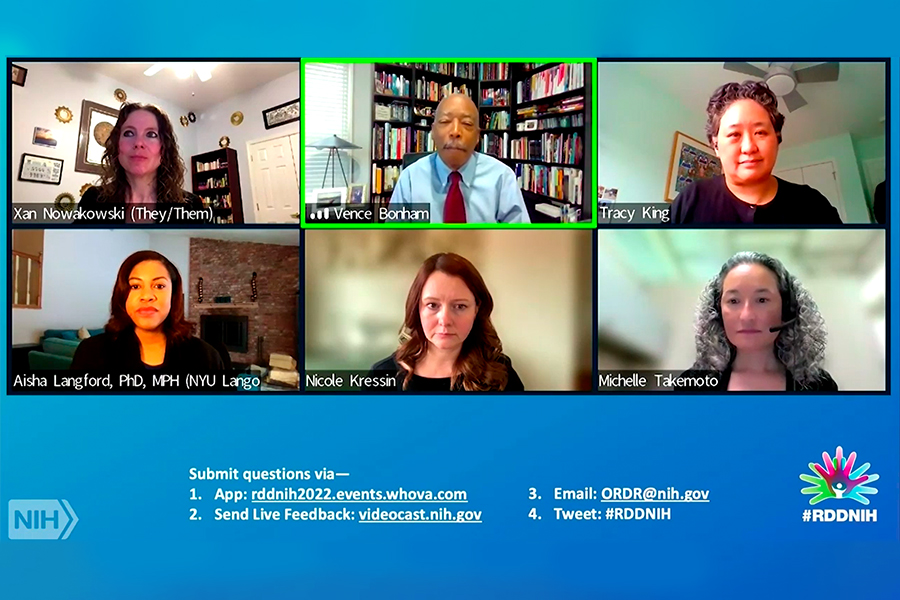Rare Disease Day at NIH 2022: Shining a Light on Patient Perspectives

P.J. Brooks, Ph.D., and Joni L. Rutter, Ph.D., raising their hands in front of the lit-up Building 38A on the NIH main campus. (NCATS)
May 11, 2022
Rare diseases are more common than many people realize. Although individually rare, they affect about 30 million people in the United States, or roughly one in 10 people. Rare diseases also are exceedingly difficult to diagnose, and even harder to treat: Of the 7,000 known rare diseases, only 5 percent have U.S. Food and Drug Administration–approved therapies. Rare diseases represent a critical public health issue.
On Feb. 28, 2022, nearly 2,500 participants from around the world gathered virtually to discuss the challenges and opportunities in rare diseases research. Co-sponsored by NCATS and the NIH Clinical Center, Rare Disease Day at NIH aims to raise awareness about rare diseases, the people they affect, and NIH collaborations that address scientific questions and advance research for new treatments. The day featured discussions on topics ranging from efforts to shorten the rare diseases diagnostic odyssey to speeding new treatment approaches for patients to understanding the impact of diversity and equity on rare diseases research.
NCATS’ efforts in rare diseases research are central to the Center’s vision of delivering more treatments to all patients more quickly. Throughout the event, speakers highlighted the ways that rare diseases affect people of all ages, cultures and walks of life. In his remarks, James K. Gilman, M.D., chief executive officer of the NIH Clinical Center, noted that Rare Disease Day at NIH is focused not only on science and medicine, but also the powerful stories of people who are affected by rare diseases.
The Diagnostic Odyssey
Joni L. Rutter, Ph.D., NCATS acting director, provided a personal story. She recounted that her mother, Dorothy, had primary myelofibrosis, a rare disorder that causes buildup of scar tissue in the blood marrow and disruption of blood cell production. She waited 15 years for a diagnosis. Even then, there were no treatments and her options for participating in clinical research were limited; the trials were located far from her home in rural Kansas.
“The diagnostic odyssey, the wait for treatment options, only to have those options be difficult to access — it’s a story that’s exhausting, and one that I share with many of you here today,” Rutter reflected. “I am dedicated to finding ways to improve all of these factors. I know I’m not alone in that sentiment. And that’s what gives me hope.”

Joni L. Rutter, Ph.D., NCATS acting director, welcomes attendees to Rare Disease Day at NIH 2022. (NCATS)
Many people with rare diseases wait years to receive a correct diagnosis. During the event, people and their families recounted their own diagnostic odysseys. One speaker, Troy Evans, described himself as a “neuromuscular disease fighter.” Evans began experiencing unexplained muscle soreness at age 21. Eventually, he began falling when he tried to run, and standing back up became harder. Evans began seeing specialists and went through many clinical tests but did not get any answers.
The diagnostic odyssey often involves misdiagnosis, multiple rounds of clinical testing and missed opportunities for treatment. An accurate diagnosis can offer the possibility of treatment and access to community support. Today, Evans is working with the NIH Common Fund’s Undiagnosed Diseases Network to continue searching for answers on his condition. Although he has not yet received a diagnosis, he remains hopeful that one will come.
People with rare diseases wait an average of 7 years to receive a correct diagnosis, and NCATS aims to shorten the diagnostic odyssey by more than half. To achieve this goal, NCATS is supporting three research projects that will study new tools and approaches to make it easier to correctly diagnose people with rare diseases.
Diversity and Equity in Rare Diseases Research
Even after receiving a diagnosis, many people struggle to get treatment for their rare disease. Tackling disparities in rare diseases research and care is a long-standing, complex problem that may involve such factors as race, ethnicity, geography, socioeconomic status and language. Vence L. Bonham, Jr., J.D., National Human Genome Research Institute acting deputy director, emphasized that discussions of equity should consider the full breadth of diversity among the rare diseases community.
“When we think about diversity, and the meaning of diversity, we all think traditionally about those things that we can see — traits that identify an individual that perceive difference,” Bonham said. “We often think about ethnicity, race, nationality, gender, disability, socioeconomic status. But that’s really only the tip of the iceberg.”

Session 1 panelists discuss the importance of promoting diversity and equity across the rare diseases community. (NCATS)
The challenges of inequities within the rare diseases community are far-reaching. People in rural areas might be unable to travel to participate in clinical trials. Language barriers can preclude people with rare diseases from receiving appropriate treatments. People of non-European ancestry often are represented poorly in clinical research, and information about associated genetic variants can be limited.
Alexandra “Xan” Nowakowski, Ph.D., M.P.H., shared a personal perspective on the effects of inequities in care for rare diseases. Nowakowski has an ultra‑rare form of cystic fibrosis and is ineligible for the next-generation therapeutics that were designed for people with more common variants associated with European populations. That ultra-rare mutation arose from Nowakowski’s multiethnic heritage. Nowakowski also recounted how a friend, a Black man, waited more than 50 years for his diagnosis — despite exhibiting the classic symptoms of cystic fibrosis from a young age — because his clinicians were uneducated on the prevalence of the disorder within communities of color.
Awareness of diversity, several speakers emphasized, is the first step to shifting mindsets and dismantling the systems that lead to inequities in research and health care. Nowakowski urged attendees to remember that each person brings a unique perspective into the discussion. “[Diversity] is incredibly important, but that’s where you start,” Nowakowski emphasized. “You must not only bring [diverse perspectives] to the table but engage us robustly at every stage, in the planning, implementation and analysis of research.”
Speakers also discussed other efforts to bring attention to diverse voices within the rare diseases community. The NCATS-led Rare Diseases Clinical Research Network recently established a Diversity Committee to address this topic more fully. More broadly, the UNITE initiative was launched in March 2021 to identify and address structural racism within and beyond the NIH-supported scientific community.
Promise of New Technologies
NCATS and the Division of Rare Diseases Research Innovation have remained committed to advancing scientific research on rare diseases by applying new technologies in a many-diseases-at-a-time approach. The Accelerating Medicines Partnership® Bespoke Gene Therapy Consortium, for example, is establishing platforms and standards to speed the development and delivery of customized or “bespoke” gene therapies. The NIH Common Fund’s Somatic Cell Genome Editing program, which is coordinated by NCATS, was established to develop tools and technologies that can improve the effectiveness of genome editing. The NCATS-led Platform Vector Gene Therapy pilot project is developing standardized protocols for gene therapy with the aim of making such treatments more accessible. Gene therapy entails replacing a malfunctioning gene with a working version. In genome editing, scientists can change the DNA sequence and help cells work properly.
Several participants shared how the latest technologies have provided hope for new treatments for rare diseases. Advances in precision medicine offer potentially broad implications for the development of personalized therapies for many rare genetic diseases. Antisense oligonucleotide treatments, for example, can be used to alter gene activity in patients, potentially countering the effects of the mutations that cause a disease.
Mehmet Kuzu shared how personalized medicine has offered new hope for his family. Kuzu’s young daughter, Ipek, was born with ataxia telangiectasia, a rare genetic disease that causes loss of muscle control and balance, as well as a weakened immune system. This disease will cause progressive cerebellar degeneration, which will affect Ipek’s ability to perform everyday tasks, such as walking, eating and speaking. After reviewing a paper on ataxia telangiectasia, Kuzu learned that an antisense oligonucleotide for Ipek’s rare mutation had been developed years ago by a team of researchers. Kuzu connected with Timothy Yu, M.D., Ph.D., a neurologist and researcher at Boston Children’s Hospital. Yu’s team has developed a customized treatment for Ipek using this technology. Kuzu remains hopeful that these treatments will improve Ipek’s quality of life.
“There are still lots of unknowns and things to be learned,” Kuzu said. “But we are excited, and we are hoping that we can give some good news to everyone in the future.”
Learn more about NCATS’ resources for the rare diseases community.


